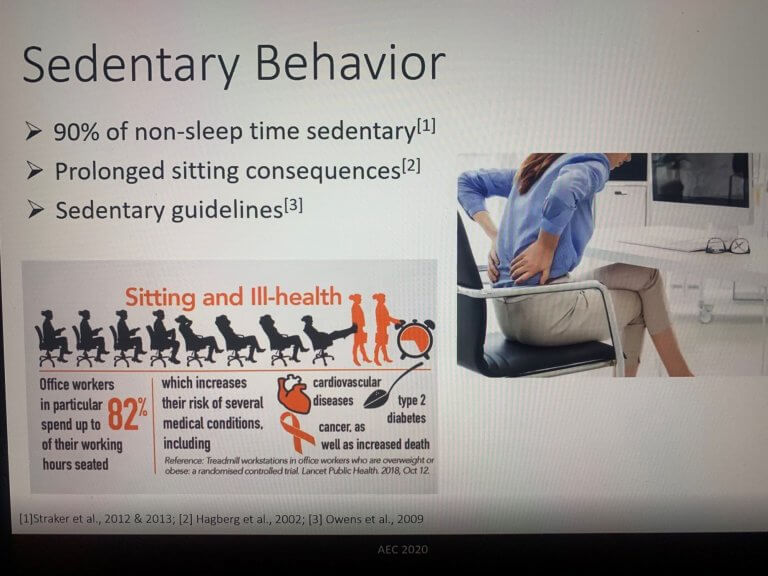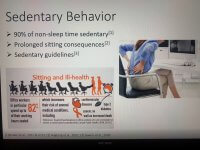Applied Ergonomics Conference – Day 3 Recap
08/11/2020

The theme of day three of the Applied Ergonomics Conference was Office Ergonomics Programs and Applications. Our team members highlighted key points from these sessions:
Computer-based Prompt’s Impact on Postural Variability and Sit-Stand Desk Usage: A Cluster Randomized Control Trial
Reviewed by Jaclyn Faraci, AEP, Associate Consultant
Grego ry Garret, Dr PH, The Boeing Company, summarizes a research study that investigates the long-term use of sit-stand workstations in office environments and the dangers of prolonged sedentary behavior. He says, “Approximately 90% of our non-sleep time is sedentary.” Typically, sit-stand desks were designed to reduce prolonged sitting and increase cognitive functioning. On the contrary, research proves that there is little to no caloric difference between static sitting and static standing. The intent of this study was to observe the effects of movement on productivity and continued use of sit-stand desks.
ry Garret, Dr PH, The Boeing Company, summarizes a research study that investigates the long-term use of sit-stand workstations in office environments and the dangers of prolonged sedentary behavior. He says, “Approximately 90% of our non-sleep time is sedentary.” Typically, sit-stand desks were designed to reduce prolonged sitting and increase cognitive functioning. On the contrary, research proves that there is little to no caloric difference between static sitting and static standing. The intent of this study was to observe the effects of movement on productivity and continued use of sit-stand desks.
In this control trial, 200 office workers were monitored over a 4-and-a-half month period to determine if computer-based prompts would impact sit-stand desk use. Prompts were displayed in the form of pop-up messages, such as, “It’s time to get up and move.” or “Make sure to meet your stand goals today.”
It was reported that 83% of workers increased their standing time, 80% reported increases in self-awareness, and 75% reported decreases in body discomfort.
Hand-Held Technology – It’s Worse Than We Thought
Reviewed by Ambrie Cwik, Marketing Coordinator
Tim Pottorff, Principal at QP3 ErgoSystems LLC, dove into the world of hand-held technology. He began the session by addressing some of the common tolls technology is taking on our health.
- Hand tendonitis can result from excessive use of a cell phone.
- Neck and back issues can arise when working on a computer or a laptop at an improper height, and when working in awkward postures, like slouching or having a bent neck for prolonged periods of time.
- Sleep deprivation and mental stress can result from the emission of blue light.
Hand-held technology is creating even more severe issues for humans! Pottorff shared these statistics and findings:
- 5 million car accidents in the US each year due to cell phone use, and on average 3,000 to 6,000 fatal accidents are reported each year (NSC).
- 11,000 pedestrian injuries occur each year due to smart device use (NSC) and 5,376 deaths per year (NHTSA).
- 259 deaths worldwide due to sightseerers trying to get that perfect selfie (2011-2017).
- 20% of kids aged 6 to 24 months old are, on average, using hand-held technology for 28-minutes a day which can cause speech delays. According to the Pediatric Academy Society in 2017, for every 30-minute increase in screen time, there’s a 49 percent increase in speech delay risk.
- 54% of employees surveyed experience high pressure to respond to emails while driving (Road Safety at Work, BC, 2016).
- Migraines can be a result of staring at a screen.
- The use of hand-held technology contributes to ADHD (McCarthy, Harvard Medical School, 2018).
Some governments have taken preventative measures. In 2020, the State of Illinois banned touching a cellphone when driving, and the city of Fort Lee (New Jersey) banned texting and walking. In Ausburg, Germany, the city officials realized that pedestrians were paying more attention to their phones when crossing the street than traffic lights, so they installed lights on the street surfaces.
Here’s what you can do:
- Use support devices like adjustable tablets, cellphone stands, and cellphone car mounts.
- Limit the amount of time adolescents use hand-held devices.
- Work in neutral postures.
- Ask others to take your photo to avoid accidents.
Visit the Applied Ergonomics Conference website and check out our Day 1 Recap and Day 2 Recap from this year’s conference.






